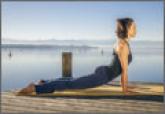Applied Evidence

Yoga as therapy: When is it helpful?
Good evidence supports the use of specific types of yoga for low back pain, depression, and anxiety. Fair evidence is available for 4 other...
Roger Zoorob, MD, MPH, FAAFP
Sangita Chakrabarty, MD, MSPH, FACOEM
Heather O’Hara, MD, MSPH
Courtney Kihlberg, MD, MSPH, FACPM
Department of Family and Community Medicine, Baylor College of Medicine, Houston, Tex (Dr. Zoorob); Department of Family and Community Medicine, Meharry Medical College, Nashville, Tenn (Drs. Chakrabarty, O’Hara, and Kihlberg)
roger.zoorob@bcm.edu
The authors reported no potential conflict of interest relevant to this article. This article was made possible by grant number IM0HP25099 from the Health Resources and Services Administration (HRSA) Integrative Medicine Program. Its contents are solely the responsibility of the authors and do not necessarily represent the official views of HRSA.

Guided imagery for anxiety and pain
Guided imagery is a relaxation technique that involves visualizing positive outcomes to reduce one’s reaction to anxiety-provoking or painful experiences.43 It can be practiced independently or under the direction of an instructor. One RCT of 96 women with newly diagnosed breast cancer found that adding relaxation and guided imagery to standard breast cancer treatment protocols positively affected mood and quality of life.14 While this study saw no change in pathologic responses to chemotherapy,14 a more recent RCT concluded that such biochemical advantages may be possible.44 Guided imagery has been linked to decreased anxiety in diverse studies of students, women in labor, individuals suffering from nightmares, and in occupational settings such as training for pilots and surgeons.15-18
A review of 9 RCTs of guided imagery for decreasing musculoskeletal pain involving 201 patients found 8 studies reported positive results, though the methodological quality of the studies was low.19 Of 6 high-quality studies included in a 2012 systematic review, 5 supported the use of guided imagery for postoperative, abdominal, and other nonmusculoskeletal pain.20 This initial evidence is promising, but additional research of high methodological quality is needed to validate the use of guided imagery for anxiety and pain.
Acupuncture for pain
From 2002 to 2007, the use of acupuncture significantly increased in the United States, primarily for the treatment of pain.1 A 2012 meta-analysis of 29 RCTs that included almost 18,000 participants evaluated the clinical usefulness of acupuncture for back, neck, and shoulder pain, OA, and headache.3 Compared to no treatment, both acupuncture and sham acupuncture significantly improved pain scores. The authors of this meta-analysis found that acupuncture offered a small but significant advantage over sham acupuncture, and concluded that the benefits of acupuncture were not due to a placebo effect.
In 2007, the American College of Physicians (ACP) and the American Pain Society (APS) issued a joint statement indicating that acupuncture should be considered for patients with chronic low back pain who do not respond to conventional therapies.4 The North American Spine Society also supports acupuncture, stating that it provides “...better short-term pain relief and functional improvement than no treatment and the addition of acupuncture to other treatment modalities provides a greater benefit than those treatments alone.”5 Additional evidence found acupuncture for chronic low back pain improves function and serves as an adjunct therapy.6
Reported adverse effects of acupuncture include—but may not be limited to—infection, skin irritation, hematoma, pneumothorax, and spontaneous needle migration.1,3-6
Yoga for low back pain
An ACP/APS statement indicates that acupuncture should be considered for patients with chronic back pain who don't respond to conventional therapies.Back pain is the most common reason patients use CAM therapies.1 A systematic review of 10 RCTs that included 967 participants with chronic low back pain found strong evidence for the short-term effectiveness and moderate evidence for the long-term effectiveness of yoga.28 A review of 17 studies that included 1626 patients concluded that yoga improves both pain and functionality; this review did not recommend a specific type of yoga practice.29 In a recent study of 95 minority adults with moderate-to-severe chronic low back pain, once-weekly and twice-weekly yoga for 12 weeks were similarly effective for reducing pain and improving functionality.30
Guidelines from the ACP and the APS recommend yoga as part of an intensive interdisciplinary rehabilitation program for patients with chronic or subacute low back pain who do not improve using other self-care options.4 This recommendation is specifically for Viniyoga, a practice in which the instructor recommends modifications to body positioning for each individual based on past injuries and overall physical condition. (For more information on therapeutic uses of yoga, see “Yoga as therapy: When is it helpful?”)
CORRESPONDENCE
Roger Zoorob, MD, MPH, FAAFP; Department of Family and Community Medicine, Baylor College of Medicine, 3701 Kirby Drive, Suite 600, Houston, TX 77098; roger.zoorob@bcm.edu

Good evidence supports the use of specific types of yoga for low back pain, depression, and anxiety. Fair evidence is available for 4 other...
As patients with type 2 diabetes become increasingly interested in alternative therapies, you need to know what to recommend—or advise against....
